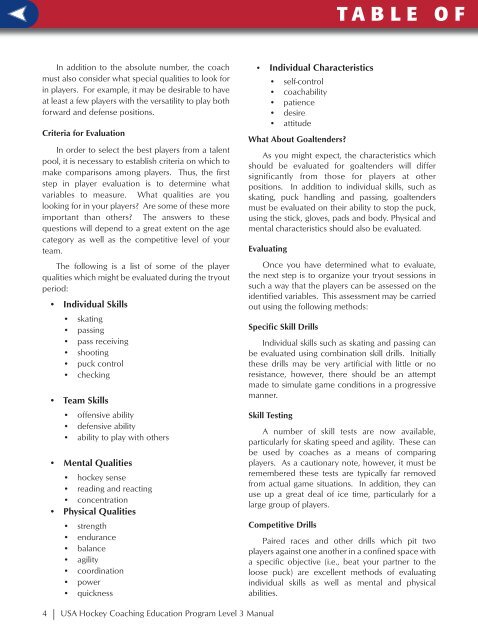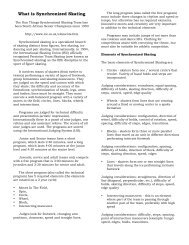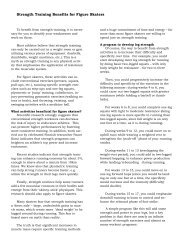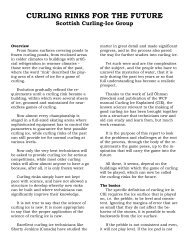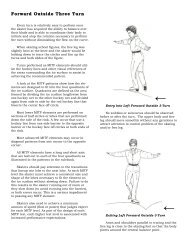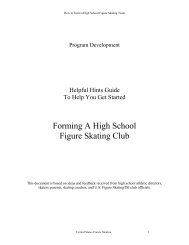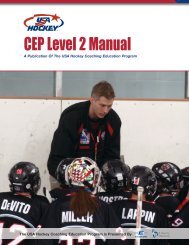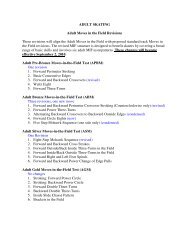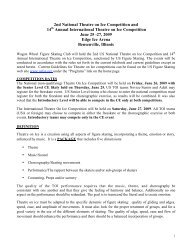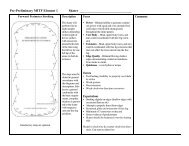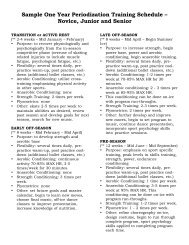CEP Level 3 Manual - Rushmore Hockey Association
CEP Level 3 Manual - Rushmore Hockey Association
CEP Level 3 Manual - Rushmore Hockey Association
Create successful ePaper yourself
Turn your PDF publications into a flip-book with our unique Google optimized e-Paper software.
T A B L E O F C O N T E N T SIn addition to the absolute number, the coachmust also consider what special qualities to look forin players. For example, it may be desirable to haveat least a few players with the versatility to play bothforward and defense positions.Criteria for EvaluationIn order to select the best players from a talentpool, it is necessary to establish criteria on which tomake comparisons among players. Thus, the firststep in player evaluation is to determine whatvariables to measure. What qualities are youlooking for in your players? Are some of these moreimportant than others? The answers to thesequestions will depend to a great extent on the agecategory as well as the competitive level of yourteam.The following is a list of some of the playerqualities which might be evaluated during the tryoutperiod:• Individual Skills• skating• passing• pass receiving• shooting• puck control• checking• Team Skills• offensive ability• defensive ability• ability to play with others• Mental Qualities• hockey sense• reading and reacting• concentration• Physical Qualities• strength• endurance• balance• agility• coordination• power• quickness• Individual Characteristics• self-control• coachability• patience• desire• attitudeWhat About Goaltenders?As you might expect, the characteristics whichshould be evaluated for goaltenders will differsignificantly from those for players at otherpositions. In addition to individual skills, such asskating, puck handling and passing, goaltendersmust be evaluated on their ability to stop the puck,using the stick, gloves, pads and body. Physical andmental characteristics should also be evaluated.EvaluatingOnce you have determined what to evaluate,the next step is to organize your tryout sessions insuch a way that the players can be assessed on theidentified variables. This assessment may be carriedout using the following methods:Specific Skill DrillsIndividual skills such as skating and passing canbe evaluated using combination skill drills. Initiallythese drills may be very artificial with little or noresistance, however, there should be an attemptmade to simulate game conditions in a progressivemanner.Skill TestingA number of skill tests are now available,particularly for skating speed and agility. These canbe used by coaches as a means of comparingplayers. As a cautionary note, however, it must beremembered these tests are typically far removedfrom actual game situations. In addition, they canuse up a great deal of ice time, particularly for alarge group of players.Competitive DrillsPaired races and other drills which pit twoplayers against one another in a confined space witha specific objective (i.e., beat your partner to theloose puck) are excellent methods of evaluatingindividual skills as well as mental and physicalabilities.Although competitive evaluation drills can beused throughout the tryouts (and during the seasonas practice drills), they are particularly useful in thelatter stages of the tryouts when the coach wishes tocreate specific pairings to compare players beingconsidered for final positions on the team.ScrimmageNaturally, the best way of evaluating a player’sability to play the game is to evaluate the individualunder game conditions. Such conditions can beeasily simulated in scrimmages. Scrimmages can beeffectively used throughout the tryout period,beginning with the first session. You can evaluatemost of the previously listed player characteristicsduring these scrimmages.Here are a few additional considerations relatedto the use of scrimmages and exhibition games inyour evaluation of players:• change line combinations and defensepairings in order to observe players underdifferent situations.• use exhibition games to help you makedecisions about borderline or marginalplayers.• unless skill deficiencies are extremelyobvious, you should not release a player priorto seeing that individual under gameconditions (i.e., scrimmage and/or exhibitiongame).An important task for any coach, then, is to planthe tryout sessions in such a way as to make themost efficient use of the available player assessmentmethods.Designing the Tryout SessionsA constructive way to approach a tryout is tosee it as a way of placing athletes on teams wherethey will benefit the most, not as a dead-endexperience where players are cut away from hockey.The tryout is a good opportunity to get somepre season skill observations which can tell both youand the athlete where work may be needed. Itshould be as well thought out and organized asother parts of your program.Planning for the First Tryout SessionProper planning will eliminate a lot of potentialproblems at the first tryout session. Therefore, thecoach should ensure that the administrative detailsare taken care of in advance. In many situations, theyouth hockey association will assume responsibilityfor some of these tasks but the coach should beaware of them in any case. The following are someguidelines related to the first tryout session.Inform Parents/Players of Tryout Details inAdvanceParents and players should be advised, well inadvance, about the requirements for the tryouts.This is particularly important at the younger agelevels where parents may not be aware of the need,for example, of full and proper protectiveequipment. In addition to informing them about theassociation’s policies regarding such aspects asprotective equipment, medical examinations andage classifications, they should also be providedwith a complete schedule of sessions and otherpertinent information regarding the conduct of thetryouts. Where feasible, this information should beprovided at a parent meeting in order to permitparents to ask any additional questions. Thismeeting format will also provide you with anopportunity to outline your player selection process.Ensure that Necessary Resources are AvailableTo be able to plan the content of the sessions, itis necessary to know what resources will beavailable. You should have sufficient pucks (at leastone for every player), pylons, and scrimmage vests.It is also desirable to have water bottles, particularlyif the sessions are intense or longer than 50 minutesin duration. A first aid kit should also be available forall sessions, along with a qualified first aid person ortrainer.Obtain Required SupportYou must anticipate your needs in terms ofhuman support to ensure that the requiredassistance is available to handle any last minutedetails. For example, it may be necessary to havesomeone available to handle late registration andcollection of registration fees. Support might alsobe required to assign identification jersey numbersto players. As already mentioned, a trainer or first4 | USA <strong>Hockey</strong> Coaching Education Program <strong>Level</strong> 3 <strong>Manual</strong>Role of the Coach | 5


